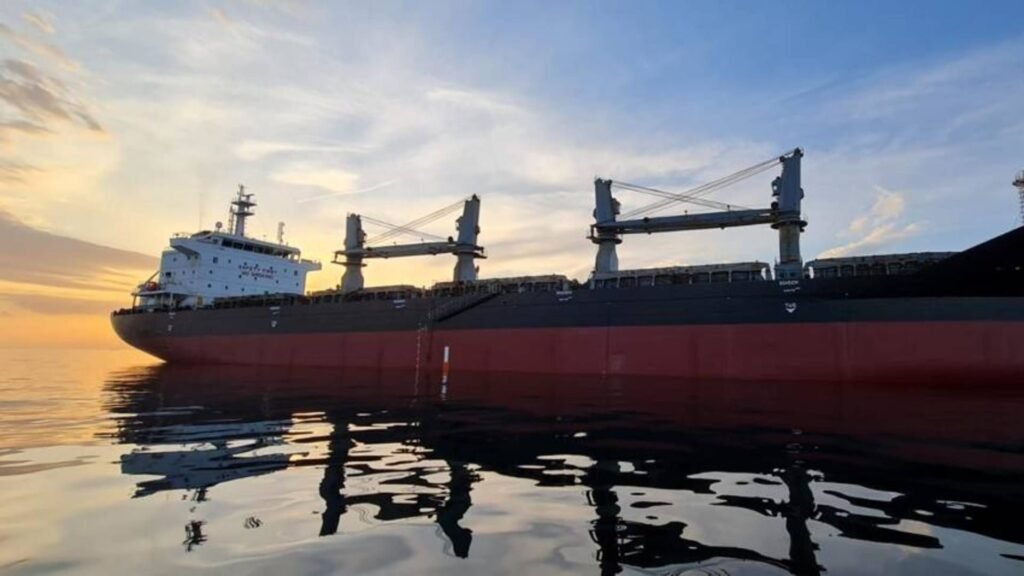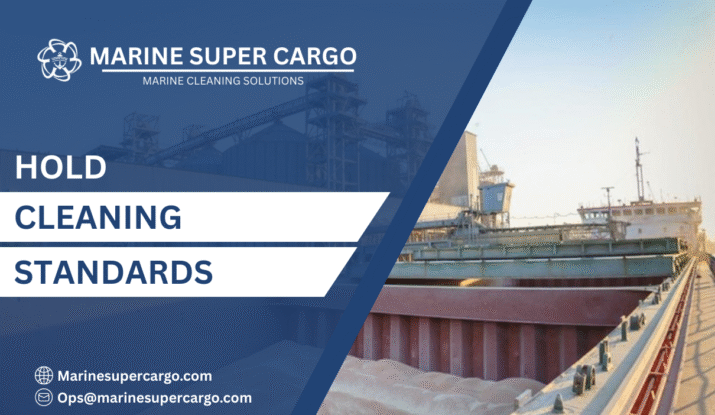Hold cleaning standards define the precise requirements for preparing bulk carrier cargo holds for different commodity types and operational needs. These hold cleaning standards establish specific cleanliness levels that vessels must achieve before loading operations can commence. Understanding various hold cleaning standards ensures compliance with charter party obligations and regulatory requirements.
Marine Super Cargo specializes in implementing diverse hold cleaning standards across global bulk carrier operations, ensuring vessels meet the most stringent requirements for any cargo type. The complexity of modern hold cleaning standards requires specialized knowledge of commodity characteristics, regulatory frameworks, and industry best practices.
Different hold cleaning standards address varying contamination risks and cargo sensitivity levels from basic sweeping to intensive decontamination procedures. These hold cleaning standards affect operations across all cargo compartments, requiring consistent application from bow to stern holds.
Professional implementation of appropriate hold cleaning standards protects cargo quality while minimizing operational delays and commercial disputes. The selection of correct hold cleaning standards depends on cargo succession patterns, charter party requirements, and destination port regulations.
Basic Hold Cleaning Standards
Shovel Clean Standard
Shovel clean represents the most basic hold cleaning standard, requiring removal of loose cargo residues and debris without extensive washing procedures. This standard applies to similar cargo types where minor contamination presents minimal commercial risk.
The shovel clean process involves manual removal of bulk residues, sweeping of accessible surfaces, and clearing of drainage systems throughout port and starboard holds. Hold cleaning standards This standard maintains basic hygiene while minimizing cleaning time and costs.
Shovel clean standards are commonly specified for coal-to-coal operations or similar industrial cargo sequences where cross-contamination risks remain acceptable under commercial terms.
Swept Clean Requirements
Swept clean standards require thorough removal of all loose materials using mechanical sweeping equipment and manual cleaning tools. Hold cleaning standards This standard addresses cargo residues in corners, frame spaces, and structural connections throughout hold areas.
The swept clean process includes detailed attention to bilge wells, tank tops, and hatch coaming areas where residual materials typically accumulate. All accessible surfaces require cleaning from the upper ‘tween decks to the tank top levels.
This standard suits cargo transitions between compatible commodities where minor residual contamination won’t compromise subsequent cargo quality or commercial acceptability.
Intermediate Cleaning Standards
Water Wash Standard
Water wash standards require comprehensive washing of all hold surfaces using pressurized water systems to remove adherent residues and contamination. This standard addresses cargoes prone to dust generation or chemical residue accumulation.
The water wash process begins with dry cleaning to remove bulk residues, followed by systematic washing from upper levels downward. Hold cleaning standards All structural elements, including frames, girders, and tank top surfaces, require thorough washing.
Marine Super Cargo emphasizes proper drainage and drying procedures following water wash operations to prevent moisture-related cargo problems during subsequent loading operations.
Detergent Wash Requirements
Detergent wash standards incorporate specialized cleaning agents to remove stubborn residues, oils, and chemical contamination that water alone cannot eliminate effectively. This standard applies to cargo transitions requiring enhanced decontamination.
The detergent selection process considers cargo characteristics, environmental regulations, and crew safety requirements. Hold cleaning standards Biodegradable detergents are preferred to minimize environmental impact while maintaining cleaning effectiveness.
Proper application procedures ensure complete residue removal while preventing detergent contamination of subsequent cargo loads. Thorough rinsing removes all cleaning agents from hold surfaces.

High-Level Cleaning Standards
Grain Clean Standard
Grain clean standards represent the most stringent cleaning requirements in bulk carrier operations, ensuring holds meet international food safety standards for grain transportation. This standard requires complete elimination of all foreign matter and contamination sources.
The grain clean process involves multiple cleaning stages including dry cleaning, washing, disinfection, and pest control measures. Hold cleaning standards All surfaces from tank tops to overhead structures require meticulous attention and verification.
Specialized equipment including high-pressure water systems, industrial vacuum units, and certified cleaning agents ensure complete contamination removal. Independent surveys verify compliance with international grain transportation standards.
Documentation requirements include detailed cleaning certificates, photographic evidence, and pest control verification to satisfy cargo receivers and regulatory authorities.
Hospital Clean Standard
Hospital clean standards exceed even grain clean requirements, establishing sterile conditions suitable for pharmaceutical products, specialty chemicals, and ultra-sensitive commodities. Hold cleaning standards This standard demands absolute elimination of all contamination sources.
The hospital clean process incorporates medical-grade disinfection procedures, air quality monitoring, and comprehensive documentation systems. Specialized personnel trained in sterile procedures perform these intensive cleaning operations.
Environmental controls including ventilation management, humidity control, and atmospheric monitoring ensure optimal conditions throughout the cleaning process and subsequent cargo operations.
Specialized Cleaning Requirements
Chemical Clean Standards
Chemical clean standards address holds previously carrying hazardous or toxic materials requiring specialized decontamination procedures. These standards often exceed normal cleaning capabilities and require professional hazmat services.
The chemical clean process may involve neutralizing agents, specialized solvents, and extensive safety precautions to protect personnel and environment. Atmospheric testing verifies complete decontamination before subsequent cargo operations.
Waste disposal procedures must comply with international environmental regulations and port authority requirements for hazardous materials management.
Food Grade Cleaning
Food grade cleaning standards ensure holds meet international food safety regulations for edible commodity transportation. These standards address both contamination elimination and pest control requirements.
The food grade process includes comprehensive surface cleaning, disinfection procedures, and verification testing to confirm absence of harmful microorganisms and chemical residues.
Certification procedures involve independent surveyors, laboratory testing, and detailed documentation to satisfy food safety authorities and cargo receivers.
Industry-Specific Standards
Coal Terminal Standards
Coal terminal cleaning standards address the specific requirements for coal loading and discharge operations. These standards focus on dust control, structural protection, and equipment maintenance considerations.
The coal terminal process emphasizes dust suppression systems, hold coating protection, and drainage system maintenance to prevent operational problems during cargo handling operations.
Marine Super Cargo maintains specialized expertise in coal terminal cleaning requirements across major global coal ports and loading facilities.
Ore Carrier Requirements
Iron ore and mineral transportation requires specific cleaning standards addressing cargo density, abrasion resistance, and structural loading considerations. These standards protect both cargo quality and vessel integrity.
The ore carrier process includes structural inspection procedures, protective coating maintenance, and specialized equipment for handling high-density cargo residues.
Quality Control and Verification
Survey and Inspection Procedures
Professional surveys verify compliance with specified cleaning standards using established inspection protocols and documentation procedures. These surveys provide objective evidence of cleaning effectiveness.
Survey procedures include visual inspections, photographic documentation, atmospheric testing, and residue sampling where required by specific standards or charter party provisions.
Independent surveyors provide credible third-party verification that protects all commercial interests while facilitating smooth cargo operations.
Documentation Requirements
Comprehensive documentation supports cleaning standard compliance while providing evidence for potential disputes or insurance claims. Digital systems improve documentation accuracy and accessibility.
Documentation packages typically include cleaning procedures, material safety data sheets, survey reports, and photographic evidence organized for easy reference.
Testing and Certification
Some cleaning standards require laboratory testing to verify complete contamination removal and compliance with specific cleanliness criteria. These tests provide objective evidence of cleaning effectiveness.
Certification procedures involve recognized testing laboratories and standardized procedures that provide credible verification of cleaning standard compliance.
Technology and Equipment Considerations
Advanced Cleaning Systems
Modern cleaning equipment enables more effective implementation of stringent cleaning standards while reducing manual labor requirements and improving safety outcomes.
Automated systems provide consistent cleaning quality while generating comprehensive documentation of cleaning procedures and effectiveness verification.
Environmental Compliance
Cleaning operations must comply with environmental regulations governing waste water discharge, chemical usage, and air emissions from cleaning activities.
Advanced treatment systems process cleaning waste water to meet discharge standards while minimizing environmental impact of intensive cleaning operations.
Conclusion
Understanding and implementing appropriate hold cleaning standards is essential for successful bulk carrier operations in today’s demanding maritime environment. From basic shovel clean to hospital clean requirements, each standard serves specific operational needs while protecting cargo quality and commercial interests.
Marine Super Cargo continues supporting vessel operators in navigating complex cleaning standard requirements while maintaining operational efficiency and regulatory compliance. Professional expertise ensures that vessels consistently meet the most demanding cleaning standards across all trade routes.
Investment in proper cleaning capabilities, trained personnel, and quality control systems enables vessels to handle diverse cargo types while maintaining the highest standards of cleanliness and operational excellence.
Frequently Asked Questions
1. What determines which hold cleaning standard should be applied?
The cleaning standard depends on cargo type, charter party requirements, previous cargo carried, and destination regulations. Food-grade commodities require grain clean or hospital clean, while industrial cargoes may only need water wash or swept clean standards.
2. How long does each cleaning standard typically take to complete?
Cleaning duration varies significantly: shovel clean takes 4-8 hours, water wash requires 12-24 hours, while grain clean can take 2-4 days depending on vessel size and contamination levels. Hospital clean may require even longer periods.
3. What’s the difference between grain clean and hospital clean standards?
Grain clean meets food safety requirements for agricultural commodities, while hospital clean achieves sterile conditions suitable for pharmaceuticals and ultra-sensitive products. Hospital clean includes additional disinfection and environmental control measures.
4. Can cleaning standards be downgraded if cargo specifications change?
Generally, cleaning standards cannot be downgraded once achieved without re-contamination. However, cargo specification changes may allow different standards for subsequent loads, subject to charter party and regulatory approval.
5. What documentation is required for different cleaning standards?
Basic standards require cleaning logs and photographs, while grain clean needs survey certificates and pest control documentation. Hospital clean requires comprehensive sterile procedure records, atmospheric testing results, and specialized certification from qualified surveyors.


